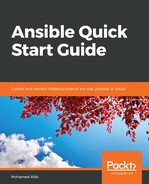Ansible uses Secure Shell (SSH) and WinRM to manage its host clients. All installation happens on either the management node or the master node, or possibly on multiple nodes when redundancy is needed. We will proceed into the installation of Ansible from source, as with Python PyPI on two major Linux families: Debian (which includes Debian, Linux Mint, Kali Linux, Ubuntu, and Ubuntu Mate) and Red Hat (which includes Red Hat, Fedora, CentOS, and Scientific Linux). We will also be looking at the Ansible installation process for Mac OS X, Python PyPI, and how to install it from the source. We will cover cloud usage and containerized Ansible.
If you have a choice, we recommend using the default package manager for Red Hat, CentOS, Debian, Ubuntu, and Mac OS X. Using the package manager allows the installation of the latest stable version of Ansible. Python PyPI can also be relied on for its capacity to deliver the latest stable version of Ansible, especially when using an old LTS or a stable Linux version.
For use in a cloud environment, there are many community instances of Ansible. We recommend using the most popular instance with the appropriate version.
